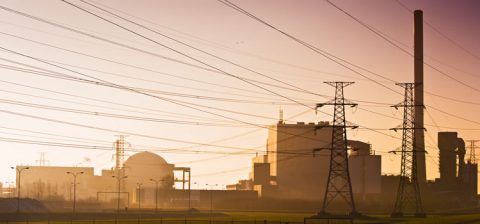
Is kernenergie op zijn retour? Of komt er een inhaalslag?
15 juli 2016 – Twee rapporten over de mondiale kernenergie-industrie in 2015, twee conclusies. Kernenergie is – ondanks een lichte groei in 2015 – op zijn retour, concluderen de auteurs van het World Nuclear Industry Status Report 2016. Nee, er komt een inhaalslag, verwacht/hoopt het World Nuclear Performance Report 2016.
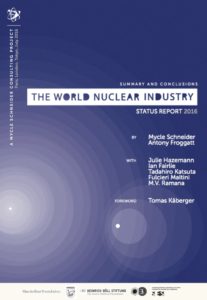 World Nuclear Industry Status Report 2016 (WNISR)
World Nuclear Industry Status Report 2016 (WNISR)
‘Wie kijkt naar de gegevens van 2015, ziet dat hernieuwbare energie hard blijft groeien en dat de productie van kernenergie, behalve in China, wereldwijd afneemt.’ Dat concluderen de onderzoekers die, onder leiding van Mycle Schneider en Antony Froggatt meewerkten aan het World Nuclear Industry Status Report 2016 (WNISR). Het is een uitgebreid overzicht van alle kerncentrales ter wereld (die er al staan, onder constructie zijn of waar plannen voor zijn) en gegevens over hun productie.
De conclusies in het World Nuclear Industry Status Report 2016:
‘(…) The China Effect
- Nuclear power generation in the world increased by 1.3%, entirely due to a 31% increase in China.
- Ten reactors started up in 2015—more than in any other year since 1990—of which eight were in China. Construction on all of them started prior to the Fukushima disaster.
- Eight construction starts in the world in 2015—to which China contributed six—down from 15 in 2010 of which 10 were in China. No construction starts in the world in the first half of 2016.
- The number of units under construction is declining for the third year in a row, from 67 reactors at the end of 2013 to 58 by mid-2016, of which 21 are in China.
- China spent over US$100 billion on renewables in 2015, while investment decisions for six nuclear reactors amounted to US$18 billion.
Early Closures, Phase-Outs and Construction Delays
- Eight early closure decisions taken in Japan, Sweden, Switzerland, Taiwan and the U.S.
- Nuclear phase-out announcements in the U.S. (California) and Taiwan.
- In nine of the 14 building countries all projects are delayed, mostly by several years. Six projects have been listed for over a decade, of which three for over 30 years. China is no exception here, at least 10 of 21 units under construction are delayed.
- With the exception of United Arab Emirates and Belarus, all potential newcomer countries delayed construction decisions. Chile suspended and Indonesia abandoned nuclear plans.
Nuclear Giants in Crisis – Renewables Take Over
- AREVA has accumulated US$11 billion in losses over the past five years. French government decides €5.6 billion bailout and breaks up the company. Share value 95 percent below 2007 peak value. State utility EDF struggles with US41.5 billion debt, downgraded by S&P. Chinese utility CGN, EDF partner for Hinkley Point C, loses 60% of its share value since June 2015.
- Globally, wind power output grew by 17%, solar by 33%, nuclear by 1.3%.
- Brazil, China, India, Japan and the Netherlands now all generate more electricity from wind turbines alone than from nuclear power plants. (…)’
World Nuclear Association (WNA)
In het algemeen brengen alleen critici van kernenergie de data uitvoerig in kaart, stelt Craig Morris in Renewables International, verwijzend naar de World Nuclear Industry Status Report. Maar nu kwam ook de World Nuclear Association (WNA) met data over de mondiale staat van kernenergie. Uit de grafieken van de WNA blijkt slechts een geringe groei in 2015, maar de organisatie verwacht (en hoopt op) groei van de kernenergiesector in de toekomst.
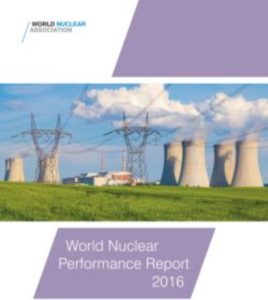 Uit het bericht van de WNA
Uit het bericht van de WNA
‘(…) To achieve [de doelen van het klimaatakkoord], the role of nuclear energy must be expanded. Our Harmony vision sets a target for 1000 GWe of new nuclear capacity to be added by 2050, so that nuclear would supply about 25% of global electricity. (…)’
De kernenergie-industrie heeft het moeilijk, stelt de WNA, maar een inhaalslag – om de benodigde reductie van de CO2-uitstoot te halen – is mogelijk.
De conclusies in een persbericht van de WNA over het World Nuclear Performance Report
‘(…) Key findings include:
- More nuclear reactors are under construction and more reactors came on line last year than at any time in the last 25 years.
- Nuclear reactor performance has improved steadily over the last 35 years. Importantly, reactor performance is not fundamentally affected by reactor age; older plants operate as well as younger plants.
- Construction times for new reactors have improved over the last 15 years, with reactors coming on line in 2015 having an average construction time of around six years. (…)’
Uit het bericht van Renewables International
‘(…) For instance, the capacity factor of nuclear reactors worldwide is just above 80% and probably reached an all-time high in 2014 – but only if we leave out the inactive but not officially decommissioned Japanese fleet.
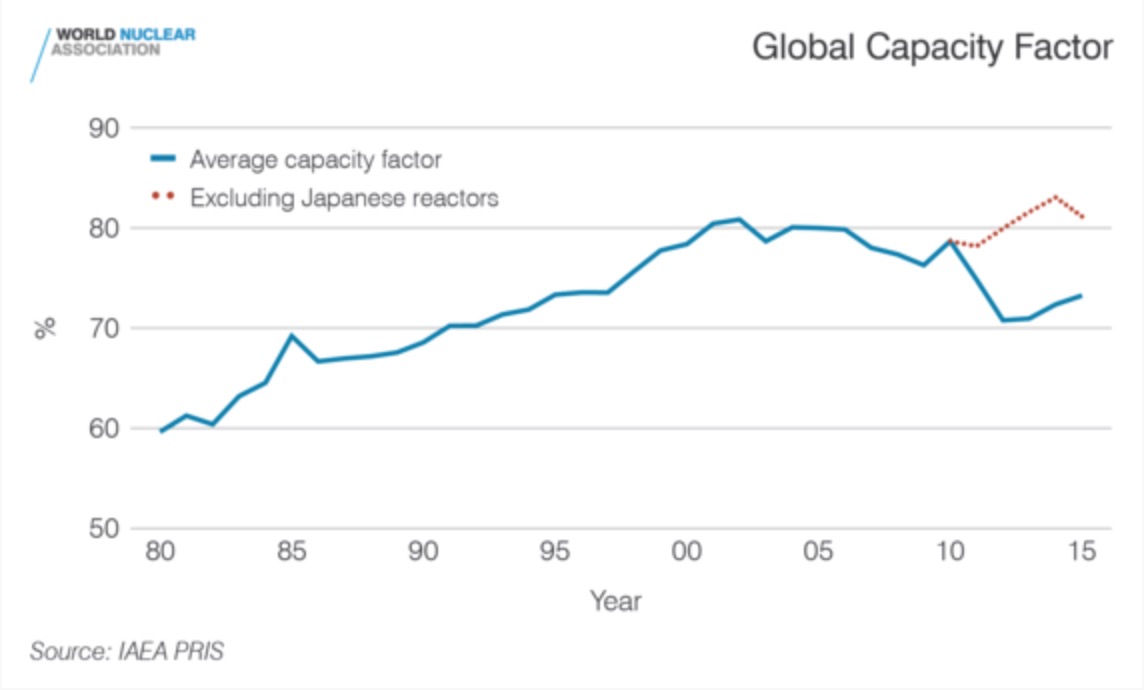
Another chart shows that the capacity factor does not drop as reactors age. This chart could potentially be used to call for an extension to reactor commissions.

We also see that the average construction timeframe for new reactors peaked around 1980 and has gone slightly down since then, with no major outliers in the past decade – all nuclear reactors completed in roughly the past 10 years were finished within around eight years. (The data stopped at 2010 and do not include Watts Bar 2.)
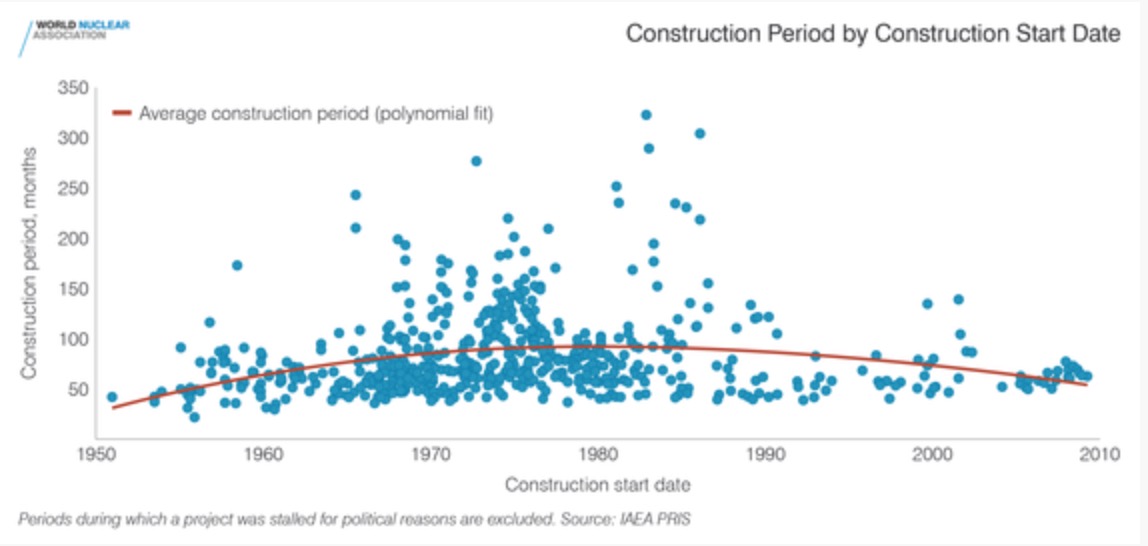
Finally, there is the chart showing how many nuclear reactors would need to be built annually by 2050 to reach the Harmony Target of 1,000 GW. Simply from the viewpoint of a chart maker, this one is the most impressive because it clearly indicates that what needs to be achieved is basically within the range of what was done in the past.
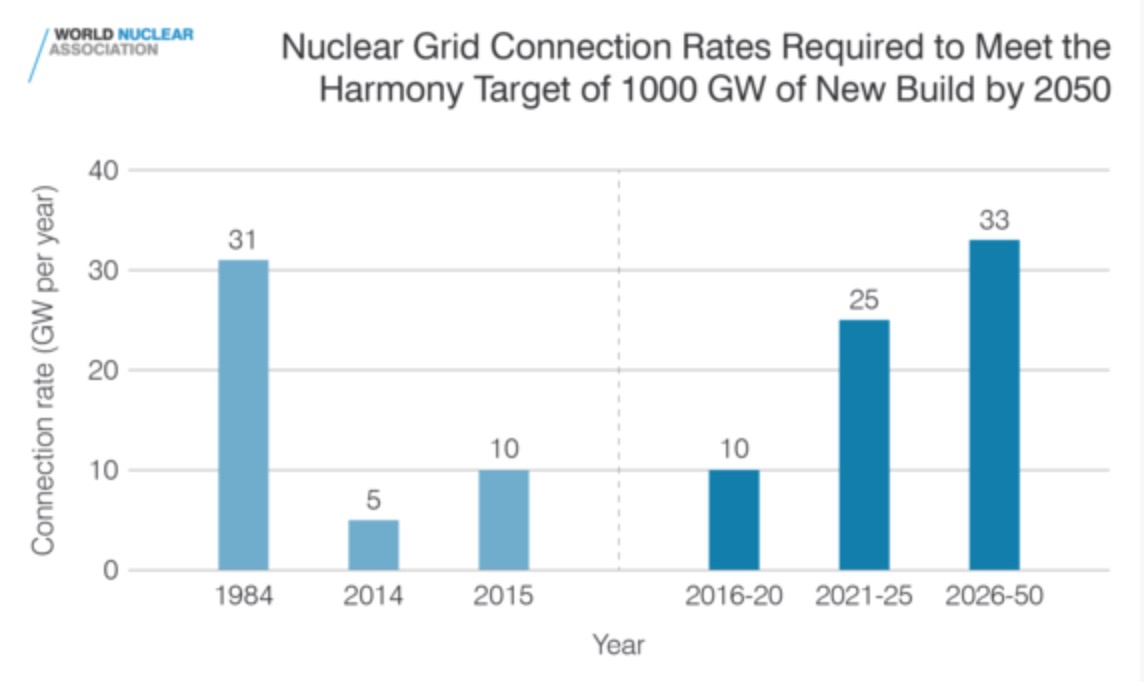
(…)’
Bronnen
World Nuclear Industry Status Report, 13 juli 2016: The World Nuclear Industry Status Report 2016 — Global Launch in Tokyo, 13 July 2016
The World Nuclear Industry Status Report 2016, Samenvatting en conclusies (pdf, 12 pag., Engelstalig)
World Nuclear Association, 21 juni 2016: World Nuclear Performance Report 2016 launch
Renewables International, 12 juli 2016: New nuclear charts
World Nuclear Association Image Library
WNA, rapport, juni 2016: World Nuclear Performance Report 2016 (link naar rapport)
Foto: FluxEnergie/© Paul Tolenaar



